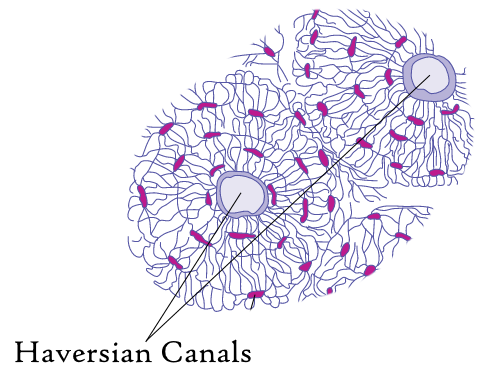
Longitudinal channels of bone are called as
a. Haversian canal
b. Volkmann’s canal
c. Narrow cavity
d. Lacunae
Answer
588.3k+ views
Hint: The channels are actually a series of microscopic tubes that are found in the outermost region of bone i.e. cortical bone and these provide a passage for the blood vessels and nerves. In each of these series, generally, one or two nerve fibers and capillaries are present.
Complete step-by-step solution:
Haversian canals are found in bones and are in the form of longitudinal channels of microscopic tubes that are formed by the concentric layers called lamellae. These canals communicate with osteocytes present in lacunae through the canaliculi and also allow blood vessels and nerves to pass through them. In the bone, osteons are arranged parallel to the surface of bone along the axis of the bone and the Haversian canals are contained within them. The Osteon or Haversian system is nothing but the composite term for the canals and surrounding lamellae together and is considered as the functional unit.

Fig.- Transverse section of a bone
Additional information:
-The arrangement of canals and surrounding lamellae in the cortical part of the bone is conductive to the mineral salt deposits and storage and thus provides strength to the bone tissue.
-Osteocytes are one of the types of bone cells and are star-shaped. These are most commonly found in mature bone tissue and their life span they live as long as the organism lives. They do not divide and their average number in an adult human is around 42 billion.
So, the correct answer is ‘Haversian canal’.
Note:
-Some small channels are present in the bone which allow blood vessels from periosteum to the bone and they also communicate with the Haversian canals. For all such channels present in the bone, the term Volkmann’s canal is used.
-In the dense matrix of bone, there are some small spaces in which osteocytes or bone cells are found, these small spaces are Lacunae.
Complete step-by-step solution:
Haversian canals are found in bones and are in the form of longitudinal channels of microscopic tubes that are formed by the concentric layers called lamellae. These canals communicate with osteocytes present in lacunae through the canaliculi and also allow blood vessels and nerves to pass through them. In the bone, osteons are arranged parallel to the surface of bone along the axis of the bone and the Haversian canals are contained within them. The Osteon or Haversian system is nothing but the composite term for the canals and surrounding lamellae together and is considered as the functional unit.

Fig.- Transverse section of a bone
Additional information:
-The arrangement of canals and surrounding lamellae in the cortical part of the bone is conductive to the mineral salt deposits and storage and thus provides strength to the bone tissue.
-Osteocytes are one of the types of bone cells and are star-shaped. These are most commonly found in mature bone tissue and their life span they live as long as the organism lives. They do not divide and their average number in an adult human is around 42 billion.
So, the correct answer is ‘Haversian canal’.
Note:
-Some small channels are present in the bone which allow blood vessels from periosteum to the bone and they also communicate with the Haversian canals. For all such channels present in the bone, the term Volkmann’s canal is used.
-In the dense matrix of bone, there are some small spaces in which osteocytes or bone cells are found, these small spaces are Lacunae.
Recently Updated Pages
Why are manures considered better than fertilizers class 11 biology CBSE

Find the coordinates of the midpoint of the line segment class 11 maths CBSE

Distinguish between static friction limiting friction class 11 physics CBSE

The Chairman of the constituent Assembly was A Jawaharlal class 11 social science CBSE

The first National Commission on Labour NCL submitted class 11 social science CBSE

Number of all subshell of n + l 7 is A 4 B 5 C 6 D class 11 chemistry CBSE

Trending doubts
Differentiate between an exothermic and an endothermic class 11 chemistry CBSE

10 examples of friction in our daily life

One Metric ton is equal to kg A 10000 B 1000 C 100 class 11 physics CBSE

Difference Between Prokaryotic Cells and Eukaryotic Cells

1 Quintal is equal to a 110 kg b 10 kg c 100kg d 1000 class 11 physics CBSE

State the laws of reflection of light




